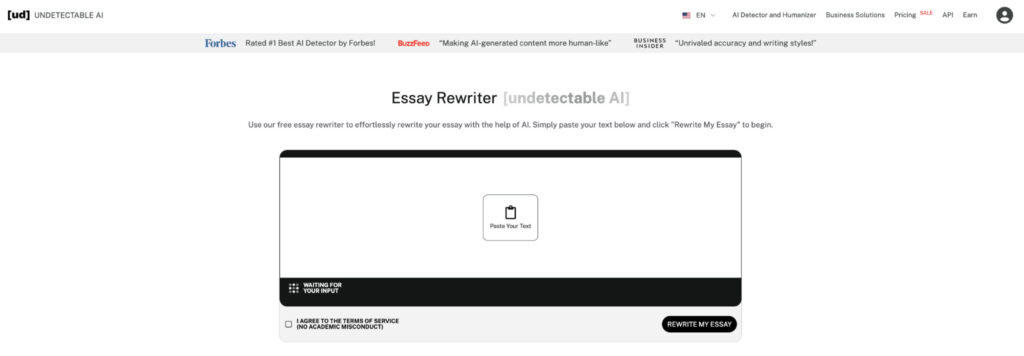Finished reading an incredible book and want to capture its essence? Summarizing is a great way to do just that.
A book summary serves many crucial functions.
One popular purpose is for authors to give potential readers a sort of teaser that can spark interest and help them decide if the book is right for them.
Nowadays, authors often use AI tools to assist with the writing process, whether it’s for brainstorming ideas or even summarizing.
But book summarizing isn’t just for marketing. It’s an essential academic skill and a valuable professional tool.
You’ll find summaries on blogs, in magazines, and at work—basically anywhere people need to get a quick grasp of a book without having to read every page.
It’s an essential skill that can give you an edge, so here’s our complete guide to help you out.
Learn the steps to writing a book summary effectively, get helpful tips, and see how AI can assist you along the way.
Let’s get started!
Key Takeaways
- The most critical step in rewriting is to maintain the original core message and emotional tone, acting as a translator from complex language to clear language.
- You should apply the 7 Essential Techniques, using strategies like paraphrasing, breaking up long sentences, and prioritizing active voice to systematically boost clarity and flow.
- The goal is objectivity, not opinion. Always avoid adding personal feelings, interpretations, or detailed critiques; stick strictly to the book’s factual content and structure.
- Never rewrite a sentence in isolation; always consider the surrounding paragraph to ensure the new sentence contributes to the overall rhythm and narrative progression.
What Is a Book Summary?
Now worth over $150 billion, the worldwide book market is huge and consistently growing.
With that, knowing how to summarize a book is a valuable skill that will stay relevant for many years to come.
A book summary is a concise, factual overview of a book. It covers the themes, key ideas, and main plot points without giving away major spoilers or delving into unnecessary details.


Never Worry About AI Detecting Your Texts Again. Undetectable AI Can Help You:
- Make your AI assisted writing appear human-like.
- Bypass all major AI detection tools with just one click.
- Use AI safely and confidently in school and work.
The goal of writing a summary is to offer enough information for the reader to understand what the book is about and decide if it’s worth reading.
But writing a book summary shouldn’t just be about shortening the content.
It’s about choosing the most important parts to highlight in a clear and highly concise way.
By focusing on the main details, you provide readers with an easy way to grasp the book’s core message, saving them time while catching their attention.
Important Distinction: A book summary is not a book review. A book review shares personal opinions and critiques, but a summary must be strictly objective and factual.
When writing a summary, your goal is to tell the reader what the book is about, not whether it is good or bad.
Why Summarize a Book? Benefits and Purposes
Even though we’re seeing a consistent rise in the book market, 44% of American adults still haven’t read a single book in the past year.
A compelling summary can grab their attention and make them curious enough to pick up a book.
Here is why summarizing books is so important:
- Useful for Academics and Professionals: Students, researchers, and professionals often need to reference books without reading them cover-to-cover. Book summaries provide a condensed version, saving time while still offering useful information.at the book is about, not whether it’s good or bad. The focus is on the content and not your personal take.
- Provides a Quick Overview: A summary gives readers a fast way to understand the book’s main ideas, themes, and characters. They don’t need to read the entire text to get the big picture.
- Helps Readers Decide on a Book: A good summary helps potential readers figure out if a book aligns with their interests or professional needs, enabling them to decide if they want to invest time in reading it.
- Aids Memory and Retention: Writing a summary forces you (the reader) to focus intently on the key concepts. It makes the material easier to remember and use later for essays, reports, or discussions.
- Facilitates Discussions: A summary highlights the main points, making it easier for readers to talk about the book with others, even if they haven’t read the full text yet.
Steps to Summarize a Book Effectively

Summarizing a book can feel overwhelming, but it doesn’t have to be. Much like summarizing an article, you can break down the process into manageable tasks.
These are the steps on how to write a book summary effectively:
1. Read the Book Carefully and Strategically
To create a great book summary, you first need to deeply understand the book. Do not just breeze through it.
Take the time to absorb the material, paying close attention to the book’s key themes, main characters, and major plot points.
If the book is long, break it into manageable sections. Read a chapter or two at a time, and then take a short break to reflect before moving on.
This method helps you digest the content in smaller chunks and improve retention.
2. Identify Key Themes and Main Ideas
As you read, think about the central message of the book.
What is the author truly trying to communicate? Are there central themes that repeat throughout, such as identity, love, betrayal, or courage?
These are likely to be crucial parts of your summary.
If you can clearly articulate the author’s purpose, then you have found the heart of the book.
3. Take Detailed Notes on Important Points
Taking notes is essential for any writing work, and that includes summarizing a book effectively.
Highlight quotes, important facts, or moments that clearly move the plot forward or reveal something about the characters or themes.
Jot down your own objective thoughts on the most noteworthy parts of the book. Remember to stay focused—do not try to write everything down.
Focus only on the highlights.
4. Organize Notes into a Simple Outline
Once you have your notes, it’s time to organize them. Group your notes by theme or chapter, whichever makes more sense for the book’s structure.
If it’s a non-fiction book, organizing by topics or arguments might work better.
This step helps you put everything in logical order and ensures you do not forget any key points.
Creating a simple outline to visualize how the ideas flow from one to the next will make the writing process much smoother.
5. Write the First Draft of Your Summary
Now that you have everything organized, you can finally start drafting your summary.
Focus on being clear and concise—do not get bogged down in the minutiae.
- Stick to the essential facts.
- Avoid giving personal interpretations or feelings; the summary must be objective.
- Write in your own words. Avoid copying directly from the book to ensure your book summary is original.
6. Edit and Refine Your Summary
There is no perfect first draft, so editing is a necessary final step. Read through your first draft and ask:
Does it make sense? Are there any sections that are too long or unclear?
- Trim the unnecessary details.
- Check that each sentence adds value.
- Read your summary aloud to check the flow. If it sounds too wordy or complicated, simplify it.
You want your readers to easily get the book’s main points and not feel overwhelmed by your writing.
Interestingly, Undetectable AI’s AI Essay Rewriter provides a sophisticated way to help you condense and rephrase book summaries during the editing phase.
By restructuring robotic or clunky sentences, the tool ensures the summary maintains the original meaning and tone while flowing more naturally for the reader.

Tips to Write Clear and Concise Summaries

Summarizing a book is all about presenting key ideas without confusing the reader. You want to be clear, precise, and impactful.
Here are some tips for writing a book summary that’s easy to understand and gets straight to the point.
1. Focus on Core Ideas Only
A professional book summary should generally be brief, often around 500 words or less. Only highlight the main themes and ideas.
Do not get caught up in every minor detail; stick to the essence of the book.
Use our Word Counter to track your word count and optimize your writing effectively. By focusing on the core ideas, you will keep your summary relevant and clear.
2. Use Simple Language
When writing your summary, avoid using complicated vocabulary or jargon.
Use clear and straightforward language so your readers of all backgrounds understand it right away.
Simple language does not mean dumbed-down; it just means you are cutting through unnecessary fluff.
For deeper insight into clear writing, a linguistics report emphasizes the importance of direct vocabulary for audience engagement.
3. Avoid Overly Detailed Explanations
As tempting as it is to explain every point in detail, a summary should never dive too deep.
The idea is to just give a sufficient overview of a book. Keep it brief and to the point.
If a particular detail isn’t necessary for understanding the core ideas, leave it out.
A literary study confirms that the most effective summaries prioritize brevity and theme over plot complexity.
How Undetectable AI Can Improve Your Summaries
AI tools can scan large volumes of text and provide you with concise versions of the content, which can help you focus on the most relevant aspects while automatically filtering out the less relevant details.
However, if you worry about your summary being detected as AI-generated content, Undetectable AI can help.
Reliable tools like Undetectable AI can help you write more effectively while ensuring your content stays authentic.
The value of AI comes from its ability to enhance the clarity of your writing while also maintaining your unique voice.
Undetectable AI ensures your refined text retains a natural, human quality, avoiding the robotic feel of machine-generated content.

- Humanizer AI: Use the Humanizer AI to instantly rewrite any section of your summary that sounds too formulaic or robotic.

- Plagiarism Check: If you worry about accidental plagiarism from your notes or paraphrasing, the Undetectable AI’s Plagiarism Checker can also give you peace of mind.
So, regardless of how much you use an AI tool, you can write confidently with Undetectable, ensuring your summaries are both readable and accurate.
Examples of Effective Book Summaries
An effective summary can work wonders for a book.
Here are examples of book summaries of some of the most popular books to give you an idea of how they’re written:
In George Orwell’s dystopian novel 1984, the protagonist, Winston Smith, lives in a totalitarian state where the government controls every aspect of life, including thought.
The story follows Winston’s rebellion against the Party, his forbidden love affair, and his eventual betrayal by the very forces he sought to defy.
The novel explores profound themes of surveillance, censorship, and the loss of individual freedom in a society dominated by an absolute authority known as Big Brother.
“To Kill a Mockingbird” by Harper Lee
Set in the 1930s South, To Kill a Mockingbird is a coming-of-age story narrated by the young Scout Finch.
Through her eyes, readers witness the intense trial of an African American man, Tom Robinson, falsely accused of sexually assaulting a white woman.
The book powerfully highlights themes of racial injustice, the painful loss of innocence, and the moral growth of Scout and her brother, Jem, under the principled guidance of their father, the lawyer Atticus Finch.
“The Great Gatsby” by F. Scott Fitzgerald
The Great Gatsby tells the tragic story of Jay Gatsby, a wealthy and mysterious man who throws lavish parties in hopes of rekindling his past romance with the now-married Daisy Buchanan.
Narrated by Nick Carraway, the novel explores complex themes of the decayed American Dream, the rigid nature of social class, and the destructive power of obsessive love.
Gatsby’s relentless pursuit of Daisy ultimately leads to his dramatic downfall, revealing the moral emptiness and shallow nature of the 1920s glitterati.
Curious to see how it works? Give the AI Humanizer a try by using the widget below and make your content sound more natural and engaging!
Final Thoughts
Learning how to summarize a book might seem like a tough task, but it’s definitely manageable when you know the right steps.
Writing a book summary requires you to focus on capturing the key themes, main ideas, and essential plot points—while keeping the details brief and avoiding spoilers.
And as you try out AI tools to streamline the process, have Undetectable AI by your side to keep your summaries credible.
With the help of AI, you can enhance the accuracy and readability of your content while maintaining originality.
